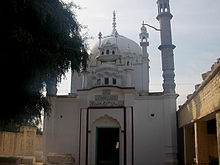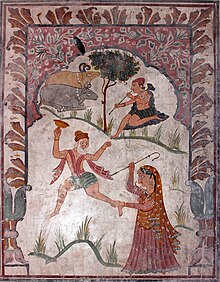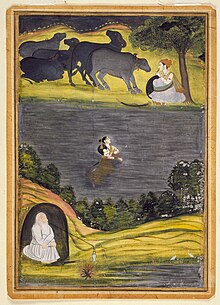This is an old revision of this page, as edited by Tareekh-e-History (talk | contribs) at 10:13, 25 October 2024. The present address (URL) is a permanent link to this revision, which may differ significantly from the current revision.
Revision as of 10:13, 25 October 2024 by Tareekh-e-History (talk | contribs)(diff) ← Previous revision | Latest revision (diff) | Newer revision → (diff) Tragic romance of Sindh and Punjab This article is about the love story. For other uses, see Sohni Mahiwal (disambiguation).| Sohni Mahiwal Suhni Mehar | |
|---|---|
 Painting depicting Sohni crossing the Chenab River using Ghada and Mahiwal waiting for her on the other side Painting depicting Sohni crossing the Chenab River using Ghada and Mahiwal waiting for her on the other side | |
| Folk tale | |
| Name | Sohni Mahiwal Suhni Mehar |
| This article is part of the series |
| Punjabi folklore ਪੰਜਾਬੀ ਲੋਕਧਾਰਾ • پنجابی لوک ریت |
|---|
| Romances |
| Folk figures |
|
|
| This article is part of the series |
| Sindhi folklore لوڪ ڪهاڻيون |
|---|
| Romances |
| Anecdotes |
| Legends or epics |
|
|
Sohni Mahiwal (Punjabi: [soː(ɦ)ɳiː məɦĩʋaːl]) or Suhni Mehar is a traditional Punjabi–Sindhi folk tragedy. Set in central Sindh or northern Punjab, depending upon the version of the tragedy, the folktale depicts the separation of two lovers and their simultaneous tragic demise.
In Sindh it is one of the seven popular tragic romances of Sindh. The other six are Umar Marvi, Momal Rano, Sassui Punnhun, Lilan Chanesar, Sorath Rai Diyach, and Noori Jam Tamachi. In Punjab, it is one of four of the most popular romances. The other three are Heer Ranjha, Sassui Punnhun and Mirza Sahiban.
Sohni Mahiwal is a tragic love story which inverts the classical motif of Hero and Leander. The heroine Sohni, unhappily married to a man she despises, swims every night across the river using an earthenware pot to keep afloat in the water, to where her beloved Mahiwal herds buffaloes. One night her sister-in-law replaces the earthenware pot with a vessel of unbaked clay, which dissolves in water and she dies in the whirling waves of the river.
Origins
The tale originated in the Soomra dynasty period in the 10th century, later it was found in the texts of Shah Abdul Karim Bulri & lastly in Shah Jo Risalo. It is one of seven popular tragic romances from Sindh, commonly known as The Seven Queens of Sindh (Sindhi:ست سورميون) of Shah Abdul Latif Bhittai. Sohni remains one of the favourite folktales both in Sindh and Punjab.
Sindhi version of the tale
The folk story of Suhni Mehar composed by Shah Latif is an old Sindhi folk narration.
Suhni belonged to the Samtia clan and was the daughter of Jarkat Samtio. While Mehar belonged to the Nagamro clan of Sindh and was the son of Gehwar Jam. Mehar's original name was Saahar. This folk narration belongs to the period of the start of the Soomra dynasty in Sindh in the 10th century. This narration is connected with one of the outlets of the Indus River, named Luhano Dhoro which then turned to flow west of Shahdadpur city. During the Arab period, this river used to flow on the east side of Shahdadpur city.
Suhni
Suhni was married to Dam (Template:Lang-sd), by caste Wahucho. During the rituals of the marriage of Suhni & Dam, their parents forgot to offer them milk as a tradition and when the married party was returning and was delayed to cross the river; while staying on a river bank, a few old ladies felt unpleasant not to offer the milk to the married couple and asked to perform the same ritual and nearby was Mehar's cattle farm who offered them milk which was drunk by Suhni. As soon as she drank the milk, she got disturbed and was attracted to Mehar. She used to visit Mehar daily while crossing the river. But she soon was exposed to her parents, who forbade her to meet Mehar but all in vain. This practice continued and her mother-in-law one night replaced the baked earthen pot with an unbaked one. Suhni did not check the pot as usual and started swimming in the river. When she reached the deep waters, the unbaked pot was destroyed and she was drowned. While she was crying, Mehar heard her and called the fisherman to save her. But it was too late and finally, the dead body of Suhni was recovered. Mehar himself buried her and got constructed a tomb over her grave which is still visited by people in Shahdadpur. Later on, after a few years, Mehar also expired and was buried in Shahdadpur City.
Tomb of Suhni

In Sindh, Suhni's shrine is located at Shahdadpur city of Sanghar District and is still visited by people.
Punjabi version of the tale

In the 18th century (late Mughal period), the beautiful girl Sohni was born to a potter named Tulla (Toolha). They were from the Kumhar caste, and lived in Gujrat, Punjab. At the time, Gujrat, on the river Chenab, was a caravanserai on the trade route between Bukhara and Delhi.
As Sohni grew up, she helped her father decorate his pots. Their shop is said to have been near Rampyari Mahal by the river. As soon as the Surahis (water-pitchers) and mugs came off the wheel, she would draw artistic designs on them and set them up for sale.
Izzat Baig of Bukhara
Shahzada Izzat Baig, a rich trader from Bukhara (Uzbekistan), came to Punjab on business and halted in Gujrat. Here he saw Sohni at the shop and was completely smitten. Just to get a glimpse of Sohni, he would end up buying the water pitchers and mugs every day.
Sohni too lost her heart to Izzat Baig. Instead of returning to Bukhara with his caravan, the noble-born Izzat Baig took up the job of a servant in the house of Tulla. He would even take their buffaloes for grazing. Soon, he came to be known as Mehar or "Mahiwal" (buffalo herder since buffalo is called Mai'n/mahi in Punjabi language).
Sohni's marriage
The love of Sohni and Mahiwal caused a commotion within the Kumhar community. It was not acceptable that a daughter from this community would marry an outsider, so her parents immediately arranged her marriage with another potter. On the day the "barat" (marriage party) of that potter arrived at her house, Sohni felt helpless and lost. She was sent off to the husband's house in a Doli (palanquin).
Izzat Baig renounced the world and started living as a faqir (hermit). He eventually moved to a small hut across the river Chenab from Sohni's new home hamirpur. In the dark of night, when the world was fast asleep, the lovers would meet by the river. Izzat would come to the riverside and Sohni would come to meet him swimming with the help of an inverted hard baked pitcher (inverted so that it would not sink). He would regularly catch a fish and bring it for her. It is said that once, when due to high tide he could not catch a fish, Mahiwal cut a piece of his thigh and roasted it. Sohni didn't realise this at first but then she told Izzat that this fish tastes different. When she kept her hand on his leg, she realised what Mahiwal had done and this only strengthened their love for each other.
Tragic end

Meanwhile, rumours of their romantic rendezvous spread. One day Sohni's sister-in-law followed her and saw the hiding place where Sohni kept her earthenware pitcher. She informed her mother, Sohni's mother-in-law, and instead of telling Sohni's husband (who was away on a business trip), the women decided to take the decision in their own hands and finish the matter. The next day, the sister-in-law removed the hard baked pitcher and replaced it with an unbaked one. That night, when Sohni tried to cross the river with the help of the pitcher, it dissolved in the water and Sohni drowned. From the other side of the river, Mahiwal saw Sohni drowning and jumped into the river to save her and drowned as well. Thus, the lovers were reunited in death.
Popular culture
The story of Sohni and Mahiwal was popularized in the Punjabi qissa (long poem) Sohni Mahiwal by Fazal Shah Sayyad, who also wrote poems on Heer Ranjha, Laila Majnu and others.
The Sohni Mahiwal love story continues to inspire numerous modern songs, including Pathanay Khan's famous song Sohni Gharay nu akhadi aj mainu yaar milaa ghadeya. Earlier Nawab Kumhar Inayat Kotia and later Alam Lohar have also made many renditions of this kalaam and were among the first singers to present the story in a song format. Pakistani pop band Noori's song Dobara Phir Se is inspired by the lore of this story as well as the more recent, Paar channa de, from Coke Studio Pakistan (season 9). Paar channa de was earlier sung by Arif Lohar and Saleema Jawwad for 2013 movie Zinda Bhaag, based on a traditional folk song.
Many paintings of Sohni Mahiwal continue to be created by well-known artists such as Sobha Singh. Folk versions of these paintings, for example in the Kangra style, are commonly found across the whole Punjab region.
Four Hindi film versions, named Sohni Mahiwal have been made in India:
- 1933 by Harshadrai Sakerlal Mehta; starring Gauhar Karnataki, Master Chonkar, Shivrani and Master Kanti.
- 1946 directed by Ishwarlal and Ravindra Jaykar; starring Ishwarlal and Begum Para.
- 1958 by Raja Nawathe; starring Bharat Bhushan and Nimmi.
- 1984 directed by Kanwal Biala, Latif Faiziyev and Umesh Mehra; starring Sunny Deol and Poonam Dhillon.
Other Indian films including silent ones based on the romance are:
- Sohni Mahiwal (1928) by K.P. Bhave, starring Gauhar Karnataki and Jamshedji.
- Sohni Mahiwal (1928) by Anand Prasad Kapoor, starring Himat, Miss Mani, Master Vithal and Zebunissa.
- Sohni Mahiwal (1939) by Roshan Lal Shorey.
- Sohni Mahiwaal (1984) by Kanwal Biala, starring Daljit Kaur, Arun Chopra, Mehar Mittal and Kanchan Mattu.
See also
References
- ʻAbd al-Laṭīf (Shah) (2018). Risalo. Harvard University Press. ISBN 978-0-674-97504-0.
- Jamal Shahid (11 January 2015). "A beloved folk story comes to life". Dawn. Retrieved 8 November 2020.
- Karan Bali (13 September 2016). "Before 'Mirzya', Mirza and Sahiban have died over and over again for their love (Numerous versions of the legend exist, including productions in Punjabi on both sides of the border)". Scroll.in website. Retrieved 8 November 2020.
- "Love Legends in History of Punjab". Punjabi World website. 20 April 2007. Archived from the original on 22 March 2019. Retrieved 8 November 2020.
- Sahibaan remains unheard The Hindu (newspaper), Published 11 October 2016, Retrieved 8 November 2020
- Annemarie Schimmel (2003). Pain and Grace: a Study of Two Mystical Writers of Eighteenth-Century Muslim India. Sang-E-Meel Publications.
- Development of Music in Sind at Google Books
- Rhythms of the Lower Indus at Google Books
- Folk music of Sind at Google Books
- Sufis of Sindh at Google Books
- Annemarie schimmel (2003). Pain and grace:a study of two mystical writers of eighteenth-century Muslim India. Sang-E-Meel Publications.
- Folk music of Sind at Google Books
- Indus Volume II at Google Books
- "The shrine of defiant love". 24 March 2015.
- Abbasi, Reema (2015-03-24). "The shrine of defiant love". DAWN.COM. Retrieved 2021-09-13.
- Folk Tales of Pakistan: Sohni Mahiwal - Pakistaniat.com
- Ikram, Sheikh Mohamad (1955). The cultural heritage of Pakistan. : Oxford University Press. p. 153.
- Amaresh Datta (2006). The Encyclopaedia Of Indian Literature. Vol. 2. Sahitya Akademi. ISBN 81-260-1194-7.
- Ashoka Jeratha (1995). The splendour of Himalayan art and culture. Indus. p. 134. ISBN 9788173870347.
- Sohni Mahiwal (1984)
- Rajadhyaksha, Ashish; Willemen, Paul (1999). Encyclopaedia of Indian cinema. British Film Institute. ISBN 9780851706696. Retrieved 12 August 2012.
External links
- Suhini- Mehar(Sohini-Mahival )
- Suhni Mehar in Sindhi
- Sur Suhni in Shah Jo Risalo
- Sohni & Mehar - The Poetry of Shah (Translated by Elsa Kazi)
Cite error: There are <ref group=lower-alpha> tags or {{efn}} templates on this page, but the references will not show without a {{reflist|group=lower-alpha}} template or {{notelist}} template (see the help page).